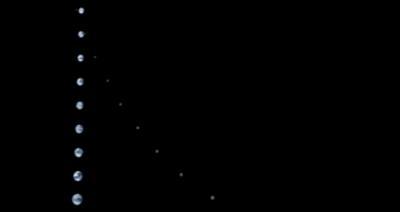When NASA's Juno spacecraft flew past Earth early in October 2013, recording a first-of-a-kind movie of the approach was a special assignment for an onboard camera system known as a star tracker.
The Juno team executed the flyby to give the spacecraft a gravity assist, increasing its speed en route Jupiter. "When Juno flew by the Earth, our speed increased by about 9,000 miles per hour, to more than 87,000 miles per hour—enough to get us to Jupiter," said Scott Bolton, director of Space Science at Southwest Research Institute in San Antonio, Texas, and Juno's principal investigator.
The maneuver also offered an extraordinary view of Earth with its moon.
"Juno had a unique opportunity to give everyone a front-row seat for the flyby—to see Earth and its moon as an approaching spacecraft sees them," said Jack Connerney, a planetary scientist at NASA's Goddard Space Flight Center in Greenbelt, Md., and the lead investigator for Juno's magnetic field instrument.
From its vantage point near the tip of one of the spacecraft's three solar-array arms, the star tracker had a terrific view. As the spacecraft approached Earth, it was turned so that the system's four cameras pointed toward the planet and away from the sun. The star tracker began capturing frames for the movie when the spacecraft was about 2.4 million miles from Earth.
"Everything we humans are and everything we do is represented in that view," said the star tracker's designer, John Jørgensen of the Danish Technical University, near Copenhagen.
Part of the star tracker's job is to send occasional pictures back to Earth throughout the mission. But as its official name, the Advanced Stellar Compass, indicates, its main job is to snap images of the surrounding star field and determine the orientation of the spacecraft. It completes this task 16 times per second.

When NASA's Juno spacecraft flew past Earth on Oct. 9, 2013, its star camera captured a unique view of the Earth-moon system, as it might look to a visitor from afar.
(Photo Credit: NASA/JPL-Caltech/DTU)
That information is vital input for Juno's magnetic sensors, which together with the star tracker make up the magnetic field instrument. This instrument will take billions of high-definition readings of the strength and direction of the magnetic field to produce an unprecedented map of the magnetic environment around Jupiter. The accuracy of each of these measurements depends on the star tracker calculating the precise orientation of the spacecraft's magnetic sensors.
During the flyby, timing was everything. Juno zoomed toward Earth about twice as fast as a typical satellite while the spacecraft itself was spinning at two revolutions per minute. To put together a movie that wouldn't make viewers dizzy, the star tracker had to be programmed to capture a frame each time the spacecraft was facing Earth at exactly the right angle. The frames were sent to Earth, where they were processed into video format.
Given the rigorous and hazardous nature of its assignment, the star tracker can't use ordinary cameras. Each one is more like a professional-grade digital camera crossed with a high-end pair of night-vision goggles. These cameras are so sensitive that the faintest star the system can detect is 3,800 times dimmer than the brightest star.
The star tracker's lenses are much more powerful than usual, with a field of view wide enough to cover about one percent of the night sky in a single frame. (In photographer's terms, the F-number is an impressive 0.7.) During the course of the Earth flyby, the star tracker took a range of pictures to cover about one-twentieth of the night sky.
Unlike the glass lenses made for cameras, the star tracker's lenses are fashioned from quartz, a material that won't darken after repeated exposure to the harsh radiation belt around Jupiter.
The 2-inch-by-2-inch cameras don't sit behind mechanical shutters because the slight movement created by repeated openings and closings would be enough to undermine the precision of the magnetic-field measurements. Instead, each camera receives an electronic impulse that clears all of its pixels before it takes the next frame. The exposure time can last anywhere from one millionth to one-quarter of a second.
The flyby provided another rare opportunity for Juno. Because Earth and the moon were both in the star tracker's field of view, the spacecraft's position could be calculated using the two objects as reference points, effectively resulting in an autonomous deep space navigation system. That position could then be compared to those determined independently by Earth-based radar systems that tracked the spacecraft while it was in the neighborhood.
The star tracker will continue to operate while Juno travels to Jupiter, looking for asteroids, comets and other interesting objects and mapping the dusty debris left by comets and asteroids that shows up as zodiacal light.
Source: NASA/Goddard Space Flight Center